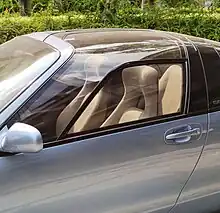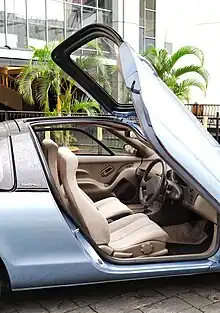| Toyota Sera (EXY10) | |
|---|---|
_front.JPG.webp) | |
| Overview | |
| Manufacturer | Toyota |
| Production | February 1990 – December 1995[1] |
| Assembly | Japan: Sagamihara, Kanagawa (Central Motors) |
| Body and chassis | |
| Class | Sport car |
| Body style | 3-door hatchback coupe |
| Layout | Front-engine, front-wheel-drive |
| Doors | Butterfly doors |
| Related | |
| Powertrain | |
| Engine | 1.5L 5E-FHE I4 |
| Transmission | |
| Dimensions | |
| Wheelbase | 2,300 mm (90.6 in) |
| Length | 3,860 mm (152.0 in) |
| Width | 1,650 mm (65.0 in) |
| Height | 1,265 mm (49.8 in) |
| Curb weight | 930 kg (2,050 lb) |
| Chronology | |
| Predecessor | Toyota AXV-II Concept |
The Toyota Sera (model designation EXY10) is a 3-door 2+2 hatchback coupe manufactured and marketed by Toyota from 1990 to 1996. It was only officially sold in Japan.
The Sera debuted in 1988 as the Toyota AXV-II concept car in a near production-ready form, and is noted for its mostly glass roof canopy and its butterfly doors, which tilt up and forward when open. Just a year later, at the 1989 Tokyo Motor Show, the production-version Sera was presented. A vertically-positioned and electrically-automated model was also shown to demonstrate the butterfly doors and rear hatch in action.
Overview


Released in a single engine configuration and body style, the Sera featured optional configurations for its transmission, brakes, cold climate and sound-system. Toyota marketed three trim versions, marketed as Phases, over its production and marketed the Sera exclusively in Japanese Toyota retail sales channels Toyota Corolla Store — as an alternative to the Toyota MR2, which was exclusive to Toyota Vista Store.
A total of 15,941 were built between February 1990 and December 1995.[1] 15,852 units were registered in Japan. Approx. 30 pre-production cars were used for development purposes.
Mechanical
The Sera came with the 1.5 L (1496 cc) inline 4 5E-FHE unleaded petrol engine, the largest capacity version of Toyota's E series of engines included in the Paseo and the Starlet. It produced 78 kW (104 hp) and 132 N⋅m (97 lb⋅ft) of torque. This was installed in a front-mount, front wheel drive transverse configuration with electronic fuel injection. All versions came with power assisted rack and pinion steering and either the Toyota A242L 4-speed automatic or the Toyota C155 5-speed manual transmission. The brakes were vented discs at the front and drums at the rear, unless fitted with the optional Anti-Lock Braking system which had vented discs all round.
Mechanically the car is related to both the Paseo and the Starlet, sharing similar floorpans, suspension, steering and brakes.
Design
Body


The Toyota Sera is a 3-door hatchback coupe of monocoque steel construction. The Sera's butterfly doors are hinged at the top center of the windscreen, and bottom of the A pillar and open forward and up in a manner similar to the McLaren F1 and Saleen S7 - the McLaren F1 designer Gordon Murray cited the Sera as the inspiration of the F1's door arrangement.[2] The weight of each door is primarily supported by a thick gas strut and counterbalanced by a smaller secondary strut inside the door.
Unlike conventional hinged side-opening doors, the butterfly doors can be opened fully in a fairly confined space, requiring only 43 cm (17 in) of lateral clearance. The Sera features windows that curve upward into the 'glass roof' section of the vehicle.
The rear hatch is constructed of a single piece of glass without a supporting steel frame. This, in combination with a steeply sloping front windscreen and glass upper-door/roof panels (a total of six separate glass pieces overall), gives the Sera its distinctive canopy and provides expansive visibility, although the thick B-pillar create a significant blind spot, especially on the driver's side. To deal with its high solar load, air-conditioning and twin removable interior roof panels are standard.
Interior
Front bucket seats feature three point seatbelts and can tilt and slide forward to give access to the rear. The rear bench seat features a fixed central arm rest and either two or three point seatbelts.
In its normal interior configuration (with the back seats up and the parcel shelf in place) the rear cargo area does have a noticeably small opening (52 cm by 82 cm) and an elevated lip necessitating the lifting of luggage quite high before it can be placed inside. However the boot (trunk) is relatively deep and spacious. In addition the rear seats fold down and both the parcel shelf and the rear divider panel (usually in place behind the back seats) can be completely removed, in essence turning the entire rear half of the car into a cargo area. As such the Toyota Sera has a large amount of available storage space for its size. The space-saving spare tire and changing kit are contained in a small compartment below the boot floor.
Other features
The Sera/EXY-10 was one of the first cars to feature projector headlights (though the 1988 AXV-II concept model featured conventional headlights).
Phases
Toyota produced the Sera in three distinct trim variants, with either manual or automatic transmission, standard or ABS brakes and regular stereo or Super-Live Sound System ("SLSS" - see below) forming the three major choices for buyers. There were also a large number of additional factory options available across the entire production run.
Phase I (March 1990 – May 1991)
The initial build and the majority of the Sera's total production (around 12,000 of the 15,852 or so cars produced) featured:
- 6 exterior colours (greenish yellow, medium blue, light turquoise (blue), wine red, dark grey and silver)
- beige/tan interior or greyish blue depending on exterior colour
- bayonet fuel filler cap
- hard-wearing ribbed and woven seat material
Phase II (May 1991 – June 1992)
Around 2,300 cars of this second trim were produced featuring:
- pastel pattern in the main sections of the seats with tan/greyish bolsters depending on interior colour
- screw-type fuel filler cap
- different seat materials
Phase III (June 1992 – December 1995)
1,550 of the final version of the Sera were manufactured, featuring:
- grey interior with seat fabrics that have a secondary colour to complement the exterior colour
- some engine component revisions
- side impact beams in the doors
- optional airbags (which may have been automatically accompanied by ABS)
- three-point rear seat belts (Some very early Phase 3 models had standard lap belts)
- stronger door struts to compensate for the side impact beams
- solid plastic spoiler with LED high-level brake light incorporated (the only external change to the Sera)
References
- 1 2 "Affiliates (Toyota wholly-owned subsidiaries)-Toyota Motor East Japan, Inc". Toyota Motor Corporation. 2012. Retrieved 2014-07-21.
- ↑ Pollard, Tim (2012-07-06). "Twelve things you may not know about the McLaren F1". Car Magazine. Lynchwood, Peterborough, Cambridgeshire, UK: Bauer Media Limited. Retrieved 2012-08-11.